by Emily Rose Hennings
France was fighting with England in a war that would later be called "The Hundred Years War." Queen Isabella of France had sided with, Duke Philip of Burgundy, to persuade the mad King Charles VI to sign a treaty with England. This treaty promised English military support to Philip against the French loyalists as well as an agreement that Henry V of England would marry the French Princess Catherine and become King of France and England. This treaty was signed in 1415 and is known as the Treaty of Troyes.
By 1422, both kings were dead. John the Duke of Bedford was assigned as regent for the infant King Henry VI, who was proclaimed the King of France and England. The true French heir Charles VII was living in exile near the Loire River while his mother was spreading rumors against his legitimacy.
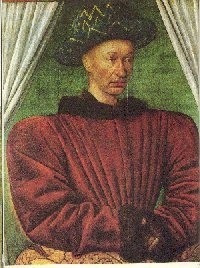
| 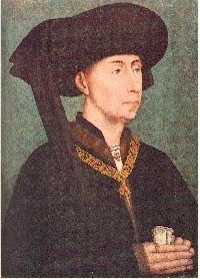 |
France was divided between Burgundians who followed the English and faithful followers of the French Dauphin or heir apparent, Charles VII. These were the turbulent times Joan of Arc was born into.
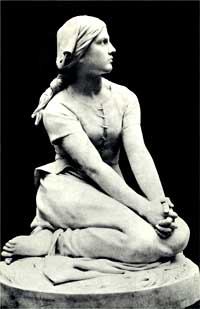
Joan as a peasant
Joan was born in 1412 in the Valley of the Meuse in the small farming Village of Domremy. Domremy was located in Burgundian territory right on the border of France, although some said it was, in fact, in the neighboring country of Lorraine. None of this mattered to the citizens of Domremy. However, they believed themselves to be
French and were loyal to their Dauphine. The Hundred Year War had gone on for so long that no one alive could remember a time of peace. There were many raids that caused the entire population of her village, livestock as well as people, to flee to the nearby castle for protection.
Domremy was like any other farming village of the late Middle Ages. Its houses of stone had no more than three rooms with simple earth floors and a central hearth for heat. Joan's house was no exception. It stood to the right of the village church with a large garden in the back. Joan spent much of her time working in the garden or helping her mother with the housework. Joan grew up like every other peasant girl of Domremy. She learned to spin and tend the village flock, she danced on holidays, and cared for the sick. She never learned to read or write. What made Joan different from the other girls was her incredible faith.
It
is said that Joan went to confession every day even when she was so young she had nothing worth confessing. She would sit and pray in front of the statues of Saints Catherine and Margaret for hours in such a deep trance she would not feel the pinch of her older brother. Joan loved the sound of the church bells ringing. She is said to have encouraged the bell ringer with small cakes so he would not forget to ring the bells on time. Whenever Joan heard the bells calling people to mass she would stop her work and pray.
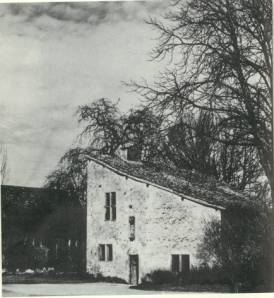 |
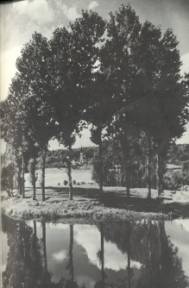 |
One day, when Joan was about twelve years old, she was working in her father's garden. When the church bells rang she later claimed that a bright light appeared coming from the direction of the church. A voice spoke from the light telling her "Be a good girl, Joan, and pious. Great things are expected of you." Joan said it was not until the third time she saw the light and heard the voice that she recognized whom it was. She believed it was the Archangel Michael, Captain of the Armies of Heaven and Defender of France. He
had great wings and was covered with a golden light, and the Hosts of Heaven stood behind him. Joan wept when she saw Saint Michael with
fear and elation. This vision became more and more frequent, up to three times a week, she later recalled.
Joan told no one of her visions, not even her priest. In the weeks that followed the first visitation, Saint Catherine and Margaret spoke to Joan. Saint Michael told her they were to be her guardians and counselors. Joan followed the example of her beloved saints and swore to remain a virgin "as long as it pleased God. Joan said she
could hear her voices best in the rustle of leaves and the church bells.
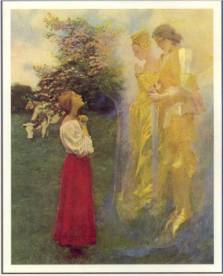
Joan seeing her vision
The voices continued to speak to her for more than four years. Until one day Saint Michael came and told her of her mission. He said she must raise the siege of Orleans, crown the King at Reims and drive the English from the kingdom of France. Joan wept for she could not understand how she, a peasant girl who knew nothing of horses or warfare, could lead the army of France.
Sources:
Brooks, Polly Schoyer. Beyond the Myth the Story of Joan of Arc. New York: Harper Collins Publishers, 1990
Dana, Barbara. Young Joan. New York: Harper Collins, 1991
Shaw, Bernard. Saint Joan. New York: Penguin Books, 1924
Twain, Mark. Personal Recollections of Joan of Arc. New York: Random House Value Publishing, Inc.1995
Williams, Jay. Joan of Arc. New York: American Heritage Publishing Co., Inc, 1963
Picture Credit:
Picture #1 - "Charles VII the Dauphin" from: Joan of Arc
Picture #2 - "Philip Duke of Burgundy" from: Joan of Arc
Picture #3 - "Map of Joan's France" from: Joan of Arc
Picture #4 - "Joan of Arc as a peasant" from: Joan of Arc
Picture #5 - "Joan's house" from: Beyond the Myth The Story of Joan of Arc
Picture #6 - "the River Meuse and Oak forest" from: Beyond the Myth The Story of Joan of Arc
Picture #7- "Joan seeing her vision" from: Personal Recollections of Joan of Arc